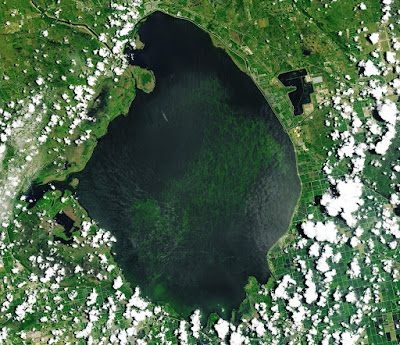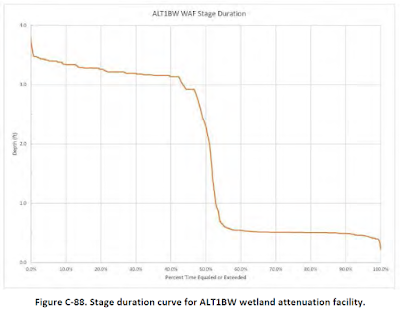Sierra Club Comments on Draft Plan for Lake Okeechobee Watershed Restoration Project
On August 20, Sierra Club and the Center for Biological Diversity submitted comments to the US Army Corps of Engineers on the Draft Integrated Project Implementation Report (PIR) and Environmental Impact Statement (EIS) for the Lake Okeechobee Watershed Restoration Project (LOWRP). Our goal is to drastically improve the plan for water storage and treatment north of the lake. See our comment letter to USACE below.

Cyanobacteria (blue-green algae) bloom on Lake Okeechobee as seen July 2, 2016, by Landsat 8 satellite. Photo credit: NASA Earth Observatory
August 20, 2018
U.S. Army Corps of Engineers
Jacksonville District
RE: Comments on the Draft PIR and EIS for Lake Okeechobee Watershed Restoration Project
On behalf of Sierra Club and the Center for Biological Diversity, we submit the following comments on the Draft Integrated Project Implementation Report (PIR) and Environmental Impact Statement (EIS) for the Lake Okeechobee Watershed Restoration Project (LOWRP).
Our organizations believe that ecosystem restoration projects in the Lake Okeechobee Watershed are important components of the Comprehensive Everglades Restoration Plan (CERP). They are important: (1) for the health of the Lake Okeechobee ecosystem and its watershed; (2) to improve the quality, timing, and quantity of freshwater flows to the northern estuaries; and (3) for the redirection of freshwater from the lake to where it is most needed, south towards to the Everglades and Florida Bay. To that end, we offer the comments below with the goal of seeing the LOWRP Tentatively Selected Plan (TSP) improved.
1. We support the wetland restoration of the Paradise Run and Kissimmee River Center sites (in Option B), which would restore about 5,300 acres to wetlands. However, there is an opportunity that should not be missed within the LOWRP to restore more wetlands. As stated in the Draft PIR/EIS, "about 330,000 acres of wetlands have been lost in the LOWRP area" and “more wetland acres restored would generally be better” (Draft PIR/ EIS, Appendix E, Attachment B). As described in the Draft PIR/EIS, the Lake Okeechobee West site (included in Option C) has a high restoration potential because it is primarily improved and unimproved pasture, with scattered freshwater marsh and wet prairie wetlands. The costs per acre for wetland restoration between Options B and C are similar. We do not agree with leaving out this excellent restoration site from further consideration just because it is not in "better ecological quality." We ask SFWMD and USACE to modify the TSP to include Option C, which would restore 2,800 additional acres of high value wetland habitat for a total of 8,100 acres (a small figure in comparison to the 300,000 acres of lost natural wetlands). The restoration of more wetlands will also provide additional opportunity for water quality improvements.
2. The goals of the CERP component referred to as "Lake Okeechobee Watershed Water Quality Treatment Facilities (OPE)" included not only wetland restoration, but also stormwater treatment areas to "retain phosphorus before flowing into Lake Okeechobee" (CERP Yellow Book, p. 9-4). The CERP Yellow Book makes it clear that an essential aspect of Everglades restoration is the inclusion of water quality features. We strongly disagree with the assumption stated in the draft PIR/ EIS that "the water flowing into CERP features will be, at a minimum, in compliance with applicable standards" (Draft PIR/EIS, section 3.4.1). This will not be the case unless water quality features are added to the LOWRP. Therefore, we request that USACE reconsider and include water quality features that are essential to Everglades restoration and improve the health of Lake Okeechobee.
3. We have concerns about the proposed Wetland Attenuation Feature (WAF), a type of feature not proposed before in CERP. While we support shallower surface water storage over deeper storage for any component of CERP, we oppose the use of Aquifer Storage and Recovery (ASR) wells to operate this feature as it is contrary to the restoration of the Everglades. According to the Draft PIR/EIS, while the WAF is primarily intended to attenuate peak flows into Lake Okeechobee, it also states that it "will create emergent wetland habitat…more natural hydrologic conditions, and improved habitat for fish and wildlife resources" (Draft PIR/EIS, pg. ES-7). However, Figure C-88 in Appendix C (see below) suggests that water in the WAF will be 3 to 3.5 ft. deep about 45% of the time and about 0.5 ft. another 45% of the time. This would mean that the change in water stage would be very drastic during the other 10% of the year, rapidly filling or emptying. This kind of hydroperiod transition does not provide for healthy wetland ecological function, even within an emergent wetland environment. The forty ASRs proposed to assist the operation of this feature would be like a form of permanent artificial "life support," creating a wetland stuck in an Intensive Care Unit.

4. Instead of the proposed WAF, we strongly recommend that this feature be modified and modeled as a water quality feature, such as a Stormwater Treatment Area (STA) and/or a Flow Equalization Basin (FEB). This will help in significantly reducing nutrient loading to Lake Okeechobee and will also reduce the level of nutrients discharged to the northern estuaries. Reducing the level of nutrients into Lake Okeechobee is essential to Everglades restoration and should not be omitted from this important CERP project. Nutrient loads to Lake Okeechobee must be reduced and LOWRP can be designed to provide such a reduction. The USACE's stated current policy of not cost sharing on water quality features should be reconsidered and modified; CERP goals make it clear these features are essential to Everglades restoration. Even if the federal government does not cost-share, whether because of administrative policy or legislation, it is still incumbent on the state to provide a locally preferred alternative that includes water quality features. Therefore, we urge USACE and SFWMD to modify this feature so it provides what the ecosystem needs, clean water for the heart of the Everglades.
5. We oppose the use of ASRs in CERP as contrary to the goals of Everglades restoration. ASRs waste public funding that is needed for actual ecosystem restoration. It is particularly troubling that half of the eighty ASR wells proposed in the TSP will inject water into the Avon Park Permeable Zone (APPZ) where water recovery is estimated at only 30%. We cannot support the wasting of freshwater via ASR wells when we have an urgent need to increase the flows of clean freshwater to the Everglades and Florida Bay, to replenish the Biscayne Aquifer in South Florida and to hold back saltwater intrusion.
6. We applaud the USACE for rejecting the use of deep injection wells; deep injection wells are inconsistent with the goals of Comprehensive Everglades Restoration Plan (CERP). In fact, the Water Resources Development Act (WRDA) of 2000, which authorized CERP, included a provision that CERP shall be implemented to ensure “the reduction of the loss of fresh water” from the South Florida ecosystem. Most recently, SFWMD stated in a June 1, 2018 letter to the Assistant Secretary of the Army for Civil Works that the "Water wasted to tide in the Northern Estuaries is THE water needed to restore the Quantity, Quality, Timing and Distribution of water within the Everglades system."
7. The Draft PIR/EIS does not clearly articulate how much each component in the TSP contributes to the reduction of harmful discharges from Lake Okeechobee and to keeping lake stages within the ecologically-preferred stage envelope. We hereby request the percentage of the benefit for the wetland restoration sites, WAF, Upper Floridan Aquifer ASRs, APPZ ASRs, and lake operational changes.
Thank you for the opportunity to provide these comments. The above list is not a comprehensive coverage of our concerns. For instance, with regard to ASRs, it is unclear what exactly is meant by the storage volume of approximately 448,000 ac-ft. per year from ASRs, what portion of the injected water is recoverable for the natural system, and how fast water can be recovered during a drought. In as much, we look forward to providing additional input on an ongoing basis as the process proceeds.
Sincerely,
Diana Umpierre, AICP
Organizing Representative, Sierra Club
Jaclyn Lopez
Florida Director, Center for Biological Diversity